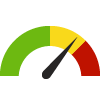Indicator Gauge Icon Legend
Legend Colors
Red is bad, green is good, blue is not statistically different/neutral.
Compared to Distribution
 the value is in the best half of communities.
the value is in the best half of communities.
 the value is in the 2nd worst quarter of communities.
the value is in the 2nd worst quarter of communities.
 the value is in the worst quarter of communities.
the value is in the worst quarter of communities.
Compared to Target
 meets target;
meets target;  does not meet target.
does not meet target.
Compared to a Single Value
 lower than the comparison value;
lower than the comparison value;
 higher than the comparison value;
higher than the comparison value;
 not statistically different from comparison value.
not statistically different from comparison value.
Trend

 non-significant change over time;
non-significant change over time; 
 significant change over time;
significant change over time;  no change over time.
no change over time.
Compared to Prior Value
 higher than the previous measurement period;
higher than the previous measurement period;
 lower than the previous measurement period;
lower than the previous measurement period;
 no statistically different change from previous measurement period.
no statistically different change from previous measurement period.
 Significantly better than the overall value
Significantly better than the overall value
 Significantly worse than the overall value
Significantly worse than the overall value
 No significant difference with the overall value
No significant difference with the overall value
 No data on significance available
No data on significance available
Households Below the Real Cost Measure
This indicator is archived and is no longer being updated. Click to learn more
Why is this important?
The Real Cost Measure is a self-sufficiency metric developed by the United Ways of California to offer a more accurate assessment of financial security of households compared to the poverty metrics alone. It supplements other poverty measures by accounting for the value of in-kind benefits, regional differences in living costs, or expenses other than food. The Real Cost Measure considers the specific costs of housing, food, health care, childcare, transportation, and other fundamental needs of households in California. To learn more about the methodology of the Real Cost Measure, visit the United Ways of California website (United Ways of California).
Considerations for Equitable Approaches: Almost all households that fall below the Real Cost Measure in California have at least one working adult. By race and ethnicity, Latino and African American households are more likely to fall below the Real Cost Measure compared to Asian American and White households. Over half of households with children under six fall below the Real Cost Measure. Households led by those with lower educational levels are more likely to fall below the Real Cost Measure.
Measurement period: 2021
Maintained by: Conduent Healthy Communities Institute
Last update: November 2023
Graph Selections
Data Source
- United Ways of California
Maintained By: Conduent Healthy Communities Institute (Methodology)
Filed under: Economy / Income, Economy / Poverty, Social Determinants of Health




